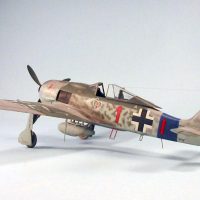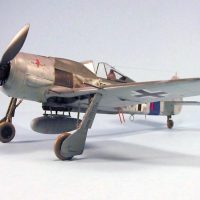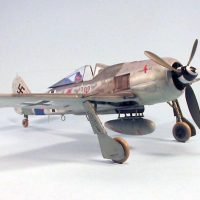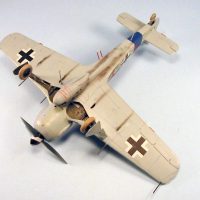The air war after D-Day – Hasegawa 1/32 Fw-190A-8 flown by Hans Dortenmann
When the Allied armies landed on the Normandy peninsula on June 6, 1944, there were fewer Luftwaffe aircraft to oppose the invasion than had been available two years earlier at the time of the Dieppe Raid. JG2 - the unit assigned to the Cherbourg Peninsula since 1941 - was widely dispersed, with the nearest unit being I/JG2, commanded by Major Erich Hohagen, which had only recently returned from the fighting at Anzio. 20 of the unit's Fw-190A-8s engaged a raid of Ninth Air Force B-26 Marauders over Pointe du Hoc during the initial phase of the invasion; this would be the biggest battle fought with the Luftwaffe on the first day. II/JG2 with Bf-109s was at Creil outside Paris, while III/JG2's Fw-190s were in the process of transferring to Fontenay-le-Comte north of La Rochelle.
The other Channel Geschwader, JG26, was even less ready to meet an invasion. II/JG26 was now based at Mont-de-Marsan south of Bordeaux, while I and III Gruppen were in transit near Reims and Metz respectively. JG26's Kommodore, Oberst Josef “Pips” Priller and his wingman, Unteroffizier Heinz Wodarczyk, were the total combat-ready force of JG26 in the invasion area. Priller's bravura low-level dash along Sword Beach has been memorialized in the book and movie, “The Longest Day.”
Altogether, the Luftwaffe managed to mount 170 sorties over the beachhead on June 6, a figure that is insignificant in comparison with the 14,000 sorties flown by the Allied air forces that day. By the end of the day, all three Gruppen of JG26 were in the invasion area, and 2./JG26's Staffelkapitaen, Oberleutnant Franz Kunz, had shot down a P-51 of the 4th Fighter Group.
After the previous five months of combat with the ever-increasing Allied air forces, the Kanalfront Geschwadern had already lost the majority of their experienced pilots, and the units were composed primarily of young enlisted flyers with less than 100 hours total time, most of whom were barely able to control their Focke-Wulfs and Messerschmitts in level flight, let alone in high-G close-in low-level fighter-versus-fighter combat. The units from Germany, with experience fighting bomber formations, would be even less-prepared for what they met over the invasion front. They were all about to be thrown into a cauldron from which the Jagdwaffe would emerge a largely-spent force.
In the following 36 hours, 200 Fw-190s and Bf-109s were flown in from Germany, leaving the Reich with only six fighter groups to defend against the Allied bombing offensive. By the end of June, 950 single-seat fighters had been fed into the invasion battle. While the fighters had flown in, the ground crews were sent by road and rail, and suffered delays and casualties from Allied air attacks. Most units deployed from the main French bases to smaller, better-camouflaged forward landing strips. Under attack on the ground and in the air, the Jagdflieger suffered 230 pilots dead and 88 wounded by July 1, with 551 aircraft shot down and a further 65 destroyed on the ground. They gave as good as they could, for instance, on June 10, Oberleutnant Addi Glunz, Staffelkapitaen of 6./JG26, a 60-victory experte and Kanalfront “alte Hasen” (old hare), shot down three P-47s in a low level combat in 2 minutes and 30 seconds. JG26 would score 150 victories between June 6 and their arrival back in Germany on September 3, but they would lose nearly 100 of their own in the same time.
Among the other units fed into the Normandy killing ground was 2 Staffel of JG54, which was brought directly from the Eastern Front to join III/JG54, which had been serving in the Reich since 1942. Among the pilots of the unit was Leutnant Hans Dortenmann, a former infantry officer who had transferred to the Luftwaffe in 1942 and had joined the unit a year previously, following graduation from flight school. Dortenmann had scored his first victory on the previous February 6 when he rammed a Lavochkin La-5; by the time he arrived in Normandy, Dortenmann had 15 victories in the East and was a leading member of the unit. Between June 10 and June 26, 1944, Dortenmann - flying his Rot Ein - would score six more victories before being shot down south of Paris on the 26th. Dortenmann survived the crash and flew on through the rest of the invasion campaign until 2./JG54 - which became 12./JG54 and a component of III Gruppe on August 10 was withdrawn along with the rest of the unit to Achmer, where they became the first Jagdgruppe to equip with the new Fw-190D-9. Flying on through the campaign in Western Europe, Dortenmann survived to be awarded the Ritterkreuz on April 20, 1945, for 35 hard-won victories in difficult circumstances. He flew his last combat mission on April 27, shooting down a Yak-3 over Berlin. With a total 18 victories while flying the Langnasen Dora, he was the leading experte on the type.
This is actually my first Hasegawa 1/32 Fw-190A, built back in 2004 (has it really been 9 years this kit has been out? Time flies when you're having fun.) The only addition was Cutting Edge posable resin seat belts. The kit painting instruction shows the airplane with a yellow panel on the lower cowling. However, the spiral on the spinner dates the airplane to later than June 15, when this identification marking was instituted on the Western Front. At the same time, colored cowling panels were deleted as an ID marking and over-painted. I had painted the yellow panel before checking this in my research, so I over-painted it in such a way that - in person - one can see a few “holidays” (old Navy term for a not-so-good coat of paint) through the RLM76 over-paint. All these colors were lightened with post-shading by adding a bit of Tamiya “Sky Grey” to each mix and going over individual panel. Xtracrykix paints used.






















Tom...Another beauty with a good back story. Nice work. The post shading looks nice and subtle.
Nice paint job...nice weathering...nice build...nice photos...nice all-around post.
lovely fw...was there really only two german fighters up at d day as the longest day proported
There were only the two over the beaches anywhere close to "early on," but as my "bit of history" above points out, JG 2 did get into it with some B-26s out toward Cherbourg in the morning, and there were a few combats by the late afternoon/early evening. 130 Luftwaffe sorties total for the day.
Tom, this is terrific, it just looks great!
That's really sharp Tom. Stuff like that tempts me to "go big".
As my artist wife says, "big canvases are more fun."
Stunning paint scheme, looks very colorful, plus great job on the model overall. A definite "like"
Beautiful...one of my favorite kits.